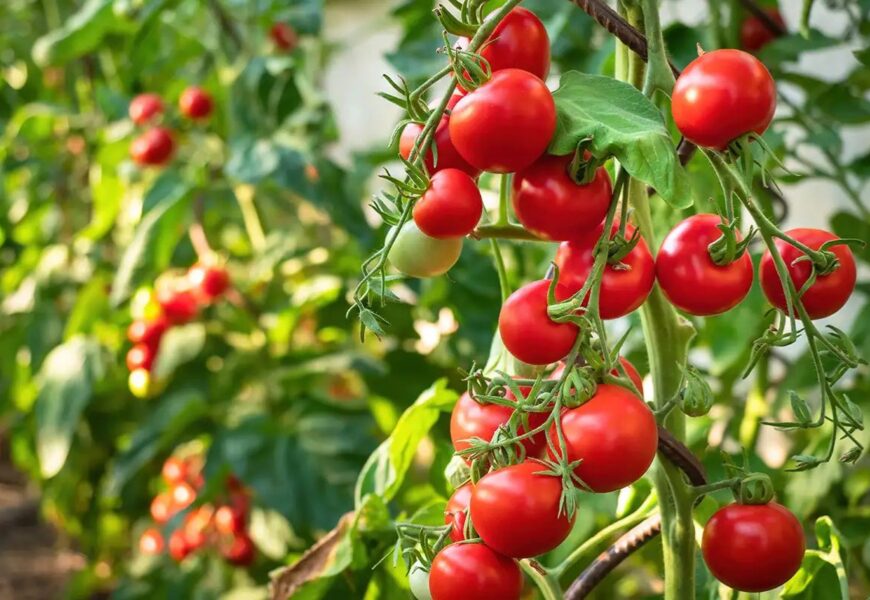Introduction
Growing healthy, high-yielding tomatoes can be challenging, but the right plant partnerships make all the difference. Using tomato companion plants strategically can naturally boost growth, repel pests, attract pollinators, and improve overall harvests. Whether you have a backyard garden or container setup, knowing which plants thrive alongside tomatoes can save time and effort. In this guide, we’ll explore the best companions, how they benefit your plants, and tips to maximize your tomato yields.
Understanding Companion Planting
Companion planting involves growing certain tomato companion plants near each other to improve growth, flavor, and resilience naturally. These plants can repel pests, attract beneficial insects, or provide nutrients to the soil. By strategically pairing tomatoes with compatible plants, gardeners can create a healthier, more productive garden. Understanding which plants work well together is the first step to maximizing your tomato yields.
Companion Plants to Boost Tomato Health
Some plants naturally enhance tomato growth by improving soil nutrients, deterring diseases, or providing physical support. Herbs like basil and vegetables such as carrots and asparagus can strengthen tomato plants and promote healthier foliage. These companions create a balanced environment that reduces stress and encourages vigorous fruit production. Incorporating these plants near tomatoes helps your garden thrive with minimal intervention.
Companion Plants That Repel Harmful Insects
Certain companion plants help protect tomatoes by naturally deterring pests and reducing the risk of infestations. By planting these near your tomato plants, you can minimize chemical use and encourage a healthier garden ecosystem. These plants act as barriers or masks that confuse or repel insects, keeping tomatoes safe and productive. Common options include:
1.Calendula
Its bright flowers attract ladybugs, lacewings, and other beneficial insects that feed on tomato pests, while its roots help suppress harmful nematodes in the soil.
2.Chives
The strong aroma of chives confuses and repels aphids, Japanese beetles, and other common tomato pests, protecting nearby plants naturally.
3.Black-Eyed Peas
In addition to enriching the soil with nitrogen, black-eyed peas act as a barrier, reducing damage from certain beetles that target tomatoes.
4.Radishes
Planted near tomatoes, radishes lure pests like aphids and hornworms away, acting as a natural decoy to safeguard the main crop.
5.Sage
Its pungent scent deters carrot flies, cabbage moths, and other pests, making it an effective companion for tomatoes and nearby vegetables.
6.Marigolds & Nasturtiums
Marigolds release chemicals that repel nematodes, while nasturtiums attract aphids away from tomatoes, serving as a living trap crop.
Companion Plants to Attract Beneficial Insects
Some plants encourage helpful insects that aid in pollination and naturally control pests, boosting tomato yields. By attracting predators like ladybugs, hoverflies, and parasitic wasps, these companions create a balanced garden ecosystem. Planting them near tomatoes supports both plant health and fruit production. Key options include:
1.Cilantro
Its delicate flowers attract beneficial insects like lacewings and parasitic wasps, which feed on common tomato pests such as aphids and caterpillars, helping reduce infestations naturally.
2.Oregano
Besides enhancing flavor in the kitchen, oregano blooms lure pollinators and predatory insects that target pests, creating a protective environment around tomato plants.
3.Parsley
Growing parsley nearby provides shelter and food for parasitic wasps and other helpful insects, supporting natural pest control and promoting healthier tomato growth.
Companion Plants for Weed Control
Certain companion plants act as natural ground covers, suppressing weeds and reducing competition for nutrients and water around tomato plants. By shading the soil and occupying space, these plants make it harder for weeds to establish. They also improve soil health, which indirectly benefits tomato growth. A notable option includes:
- Crimson Clover: Grows quickly to cover soil, suppress weeds, and enrich soil with nitrogen for healthier tomato plants.
Companion Plants to Increase Pollination
Some flowering plants attract pollinators like bees and butterflies, which are essential for tomato fruit development. By planting these near tomatoes, you can improve pollination rates and increase overall yields. These companions also add beauty and biodiversity to your garden. Key options include:
- Lavender: Its strong fragrance attracts a wide variety of bees, increasing the chances of tomato flowers being pollinated. Lavender also adds a touch of beauty and aromatic appeal to the garden.
- Sunflowers: Tall and sturdy, sunflowers act as natural windbreaks while drawing pollinators like bees and butterflies toward nearby tomatoes. They also provide habitat for beneficial insects that help control pests.
- Zinnias: Their bright, vibrant flowers are magnets for pollinators, improving tomato fruit set and overall yields. Zinnias also enhance garden diversity and encourage a healthy ecosystem.
Companion Plants Suitable for Container Gardening
When growing tomatoes in containers, selecting compatible companion plants helps maximize space, improve soil health, and support plant growth. These companions can attract beneficial insects or provide ground cover without overcrowding the container. Choosing the right pairings ensures a thriving mini-garden. Recommended options include:
- Sweet Alyssum: This delicate, low-growing flower not only adds beauty to container gardens but also attracts bees, hoverflies, and other beneficial insects that help pollinate tomatoes and control pests naturally.
- Thyme: A hardy herb that thrives in containers, thyme emits a strong scent that deters harmful insects while supporting tomato growth and adding a flavorful touch to your kitchen garden.
Also, read: Front Lawn Cheap Simple Front Yard Landscaping Ideas
Plants to Avoid Planting with Tomatoes
Not all plants thrive alongside tomatoes, as some can compete for nutrients, attract pests, or increase disease risk. For example, members of the brassica family, such as cabbage and broccoli, can stunt tomato growth when planted nearby. Corn may attract tomato pests like aphids, while fennel can inhibit tomato development. Understanding which plants to avoid helps maintain a healthy, high-yield garden and is an important consideration when planning tomato companion plants. Careful planning ensures tomatoes get the space and nutrients they need to flourish.
Maximizing the Benefits of Companion Planting
To get the most from companion planting, it’s important to combine plants that complement each other in growth, pest control, and nutrient needs. Strategically pairing tomatoes with the right herbs, flowers, and vegetables can reduce diseases, improve soil fertility, and boost overall yields. Rotating companions and monitoring plant health ensures long-term garden success. Companion planting also encourages biodiversity, creating a balanced ecosystem that supports pollinators and beneficial insects. Thoughtful planning and observation are key to achieving healthier, more productive tomato plants.
Practical Tips for Successful Tomato Companion Planting
Successful tomato companion plants planting requires careful planning of spacing, sunlight, and soil conditions to ensure each plant thrives. Grouping compatible plants together maximizes their benefits, such as pest control and improved pollination. Regularly monitoring for signs of stress, disease, or overcrowding helps maintain a healthy garden. Mulching and proper watering further support growth and reduce weed pressure. By combining these strategies, gardeners can create a productive, low-maintenance environment for robust tomato yields.
Conclusion
Incorporating the right tomato companion plants into your garden is a simple yet powerful way to boost plant health, reduce pests, and increase yields naturally. By thoughtfully pairing tomatoes with compatible herbs, flowers, and vegetables, you create a balanced ecosystem that supports growth and productivity. Whether you’re gardening in the ground or in containers, these strategies make your tomato plants stronger and more resilient. With careful planning and observation, you can enjoy a bountiful harvest season after season.
Also, read: White Pothos – Variegation of Magical Beauty















